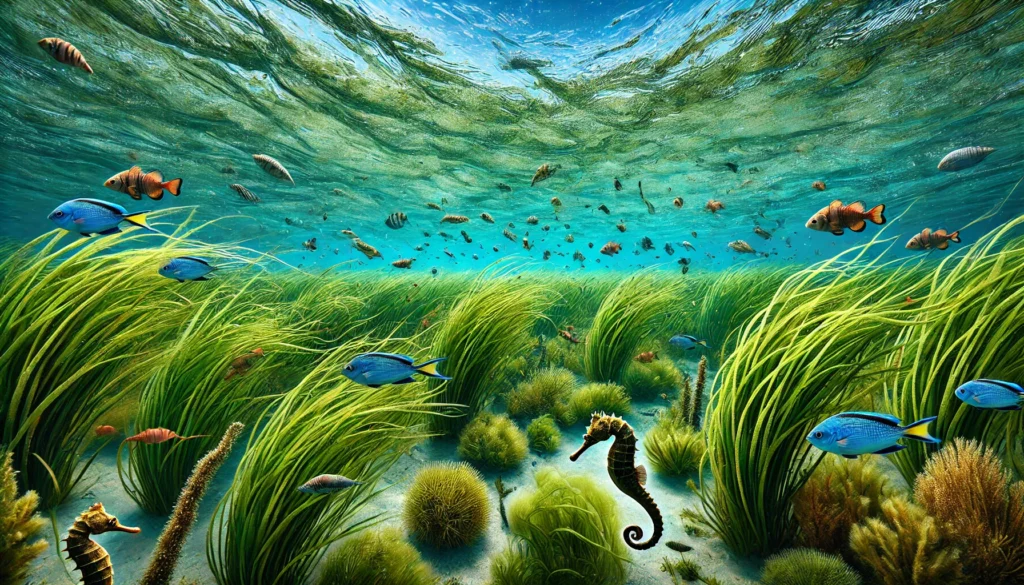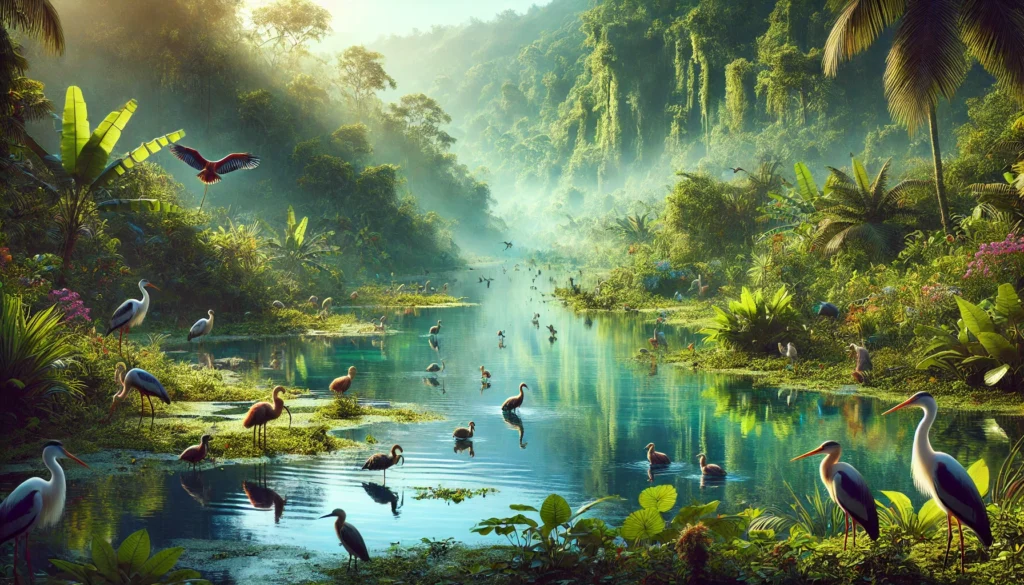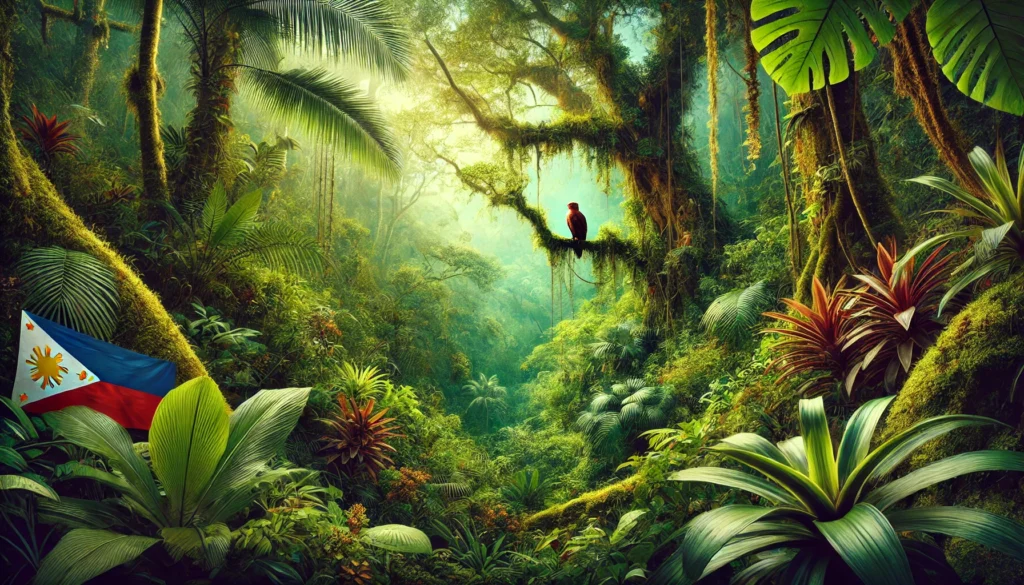Ahoy, fellow ocean enthusiasts and curious landlubbers! Today, we’re taking a deep dive into the wonderfully weird and wildly important world of seagrass meadows. Now, I know what you’re thinking: “Seagrass? Isn’t that just the annoying stuff that gets tangled in my toes at the beach?” Well, hold onto your snorkels, because we’re about to embark on a journey that’ll make you see these underwater lawns in a whole new light!
Imagine an underwater world where fish play hide-and-seek, seahorses swing on green tendrils like they’re in an aquatic playground, and turtles munch on salad bars that stretch for miles. Welcome to the seagrass meadow, nature’s very own submarine Garden of Eden! These submerged grasslands are the unsung heroes of our oceans, working tirelessly behind the scenes to keep our marine ecosystems in ship-shape condition.
The ABCs of Seagrass: Not Your Average Lawn
What exactly is seagrass?
Before we dive deeper, let’s clear up a common misconception: seagrass isn’t a type of seaweed. In fact, it’s not even closely related to the algae family. Seagrasses are honest-to-Neptune flowering plants that decided to take the plunge and adapt to life underwater. Talk about commitment to the marine lifestyle!
These aquatic overachievers evolved from land plants about 100 million years ago. They’ve got it all: roots, stems, leaves, flowers, and seeds. But unlike their terrestrial cousins, seagrasses can live completely submerged in saltwater. They’re like the Navy SEALs of the plant world – highly trained, adaptable, and ready to thrive in the most challenging underwater environments.
There are about 60 species of seagrass worldwide, ranging from the tiny Halophila decipiens, which could easily hide under a coin, to the massive Posidonia oceanica, which can grow leaves up to 1.5 meters long. That’s right, some seagrass species are taller than your average basketball player!
Where can you find these underwater meadows?
Seagrass meadows are the social butterflies of the marine world – they’re found on every continent except Antarctica. From the tropical waters of the Caribbean to the chilly coasts of Alaska, these adaptable plants have set up shop in coastal areas around the globe. They’re particularly fond of shallow, sheltered waters where they can soak up plenty of sunlight for photosynthesis.
Some of the world’s largest seagrass meadows include:
- The Great Barrier Reef, Australia: Home to over 5,000 square kilometers of seagrass beds.
- Florida Bay, USA: Boasting an impressive 14,000 square kilometers of seagrass.
- Shark Bay, Western Australia: With a whopping 4,000 square kilometers of seagrass meadows.
The Superpowers of Seagrass: More Than Just a Pretty Seafloor
Carbon Sequestration: The Climate Change-Fighting Ninjas
Hold onto your biodegradable hats, folks, because seagrass meadows are secret climate change-fighting ninjas! These underwater grasslands are absolute champs at carbon sequestration – the process of capturing and storing carbon dioxide from the atmosphere. In fact, they’re so good at it that they’ve earned the nickname “Blue Carbon” ecosystems.
Here’s a mind-blowing fact for you: seagrass meadows can store up to 18% of the world’s oceanic carbon, despite covering less than 0.2% of the seafloor. Talk about punching above their weight class! They’re like the Tardis of the ocean – much bigger on the inside when it comes to carbon storage.
Let’s put this into perspective with some numbers:
| Ecosystem | Carbon Storage Capacity (per hectare) |
|---|---|
| Tropical Rainforest | 200-400 tons |
| Seagrass Meadow | 400-3,000 tons |
That’s right, seagrass meadows can store up to 15 times more carbon per hectare than tropical rainforests. So next time someone talks about saving the Amazon (which is still super important, by the way), you can chime in with “But what about the seagrass?”
Biodiversity Hotspots: The Underwater Cities
If seagrass meadows were a real estate listing, they’d be advertised as “Luxurious underwater condos with all amenities included!” These green underwater forests are biodiversity hotspots, providing food, shelter, and nursery grounds for thousands of marine species.
Picture this: a bustling underwater city where seahorses cling to swaying grass blades, juvenile fish play hide-and-seek among the leaves, and manatees (aka sea cows) graze peacefully on the grassy buffet. It’s like New York City, but with better air quality and more fish.
Some of the cool critters you might spot in a seagrass meadow include:
- Dugongs (the mermaid-inspiring sea cows)
- Sea turtles (who love a good seagrass salad)
- Seahorses (nature’s own underwater carousel horses)
- Sharks (yes, even these toothy predators love a good seagrass hangout)
- Countless species of fish, crustaceans, and mollusks
In fact, seagrass meadows support such a diverse array of life that they’re often referred to as the “nurseries of the sea.” It’s like an underwater daycare center, but with more fish poop.
Water Quality Improvement: Nature’s Filtration System
If seagrass meadows had a LinkedIn profile, “Expert Water Purifier” would definitely be listed under skills. These underwater plants are nature’s own filtration system, working tirelessly to keep coastal waters clean and clear.
Here’s how they do it:
- Their dense network of leaves acts like a giant sieve, trapping sediments and particles floating in the water.
- The roots and rhizomes (underground stems) stabilize the seafloor, preventing erosion and reducing turbidity.
- They absorb excess nutrients from the water, helping to prevent harmful algal blooms.
It’s like having a Brita filter the size of a small country working 24/7 to keep our oceans clean. And the best part? It’s 100% eco-friendly and doesn’t need its filter changed every few months!
The Threats: Trouble in Paradise
Now, I hate to be a party pooper, but it’s not all sunshine and clear waters in the world of seagrass. These underwater heroes are facing some serious challenges, and it’s time we talked about it. Cue the dramatic music!
Coastal Development: The Concrete Jungle Meets the Seagrass Savanna
As coastal areas become more developed, seagrass meadows are often the first to feel the squeeze. It’s like trying to maintain a beautiful garden while your neighbors keep expanding their driveways onto your property. Dredging for ports, building waterfront properties, and other coastal developments can directly destroy seagrass habitats or alter water flow patterns, making it difficult for seagrass to thrive.
Pollution: When the Ocean Gets a Bad Case of Indigestion
Just like how too much junk food can wreak havoc on our bodies, pollution can do a number on seagrass meadows. Excess nutrients from agricultural runoff and sewage can lead to algal blooms that block sunlight and suffocate seagrass. Meanwhile, chemical pollutants can directly harm the plants and the animals that call them home. It’s like trying to grow a garden in a parking lot – not exactly ideal conditions.
Climate Change: The Ultimate Party Crasher
As if pollution and coastal development weren’t enough, climate change is crashing the seagrass party like an uninvited guest who eats all the snacks and then floods the house. Rising sea temperatures and ocean acidification can stress seagrass plants, making them more susceptible to disease and less able to photosynthesize effectively. Plus, extreme weather events like hurricanes can physically uproot entire meadows. It’s like Mother Nature decided to play a game of underwater Jenga with our seagrass ecosystems.
The Silver Lining: Hope Floats (and So Does Seagrass)
Before you start feeling like you need to grab a snorkel and single-handedly save all the world’s seagrass (please don’t try this, by the way), let me share some good news. There’s hope on the horizon, and it comes in the form of increased awareness, conservation efforts, and some pretty cool scientific advancements.
Restoration Projects: Bringing Sexy Grass Back
Scientists and conservationists around the world are working on seagrass restoration projects that would make any gardener green with envy. These projects involve replanting seagrass in areas where it’s been lost, kind of like underwater landscaping.
One particularly cool method is the use of biodegradable mats made from natural fibers. These mats are seeded with seagrass and then anchored to the seafloor. As the seagrass grows, the mat naturally decomposes. It’s like giving the seagrass a temporary scaffold to help it get established. Talk about a grass roots movement!
Protection Policies: Legal Guardians of the Seagrass
Governments and international organizations are starting to wake up to the importance of seagrass. Many countries have implemented policies to protect these valuable ecosystems. For example:
- In the United States, seagrass is protected under the Clean Water Act.
- The European Union includes seagrass habitats in its Natura 2000 network of protected areas.
- Australia has established several Marine Protected Areas that include seagrass meadows.
It’s like seagrass finally got its own team of lawyers to fight for its rights. Go, seagrass, go!
Citizen Science: Everyone Can Be a Seagrass Superhero
One of the coolest trends in seagrass conservation is the rise of citizen science projects. These initiatives allow regular people (yes, that means you!) to contribute to seagrass research and monitoring. From mapping seagrass distributions using smartphone apps to participating in seagrass planting events, there are tons of ways for ocean enthusiasts to get involved.
It’s like being part of an underwater neighborhood watch, except instead of keeping an eye out for suspicious activity, you’re helping to protect and restore vital marine habitats. Plus, it’s a great excuse to spend more time at the beach. For science, of course!
Seagrass – The Marine Ecosystem’s MVP
As we surface from our deep dive into the world of seagrass meadows, I hope you’re feeling as excited about these underwater wonders as I am. From their carbon-sequestering superpowers to their role as nature’s water purifiers and marine nurseries, seagrass meadows truly are the unsung heroes of our oceans.
So, the next time you’re at the beach and feel something tickling your toes, take a moment to appreciate the incredible ecosystem beneath the waves. That annoying seagrass might just be saving the world, one carbon dioxide molecule at a time.
Remember, whether you’re a scuba diver, a coastal property owner, or just someone who enjoys a day at the beach, we all have a role to play in protecting these vital ecosystems. So let’s raise a glass (of seawater, perhaps?) to seagrass meadows – the true MVPs (Most Valuable Plants) of the marine world!
And who knows? Maybe one day we’ll have underwater lawn mowers and seagrass will finally get the respect it deserves in the gardening community. Until then, keep calm and seagrass on!
Disclaimer: This blog post is based on scientific data available up to 2020. While we strive for accuracy, the marine environment is dynamic and continuously studied. If you spot any inaccuracies or have updated information, please let us know so we can keep this post as current as a strong ocean current!




